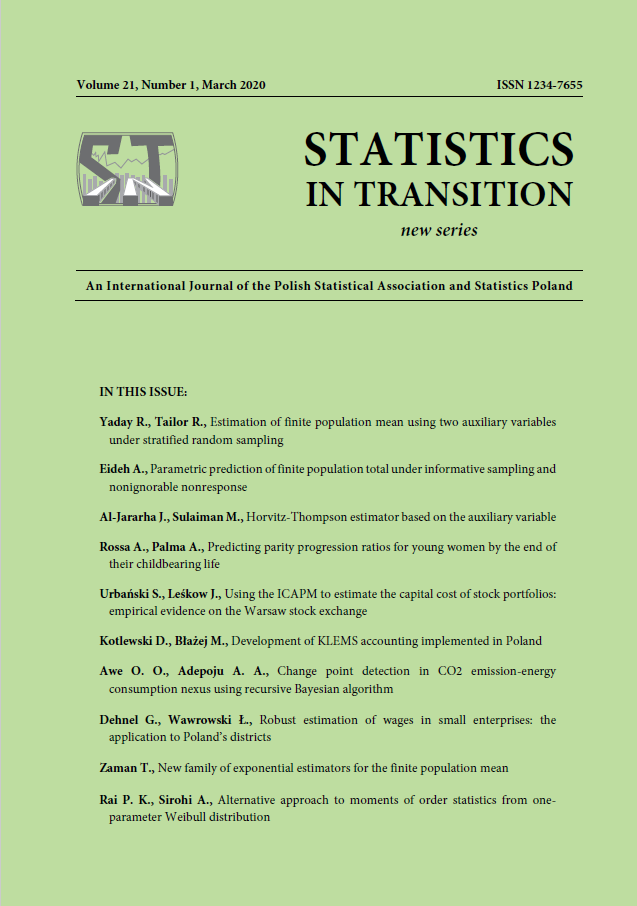ARTICLE
ABSTRACT
Parity progression ratios (PPR’s) have been extensively described in literature on demography and have played an important role in fertility, unlike the idea of calculating projected parity progression ratios proposed by Brass (1985). However, we decided to use this method in our paper to analyse future fertility trends, firstly by assessing age-specific parity progression ratios for women in childbearing ages, and then by comparing these ratios with ratios at the end of women’s reproductive life, as well as by comparing the latter with the completed PPR’s. More specifically, the aim of this study is to adopt a modified Brass method to calculate the projected parity progression ratios using the age-period fertility data sourced from the Human Fertility Database (HFD). We progress to use the observed and predicted age-specific PPR’s to examine parity progressions in Poland as a case study.
KEYWORDS
fertility rates, parity, projected parity progression ratios
REFERENCES
BILLARI, F. C., KOHLER, H.-P., (2004), Patterns of low and very low fertility in Europe, Population Studies, Vol. 58(2), pp. 161–176.
BHARDWAJ, S. B., SHARMA, G. C., KUMAR, A., (2010), Analysis of the Parity Progression Ratios, Journal of Reliability and Statistical Studies, Vol. 3(1), pp. 37–41.
BRASS W., (1985), Advances in Methods for Estimating Fertility and Mortality from Limited and Defective Data, London: Centre for Population Studies, London School of Hygiene and Tropical Medicine.
EUROSTAT. Fertility statistics. Data extracted in June 2019 .
FREJKA, T., CALOT, G., (2001), Cohort reproductive patterns in low fertility countries, Population and Development Review, Vol. 27(1), pp. 103–132.
FREJKA, T., (2008). Parity distribution and completed family size in Europe Incipient decline of the two-child family model, Demographic Research, Vol. 19(14), pp. 4–72.
FEENEY, G., (1983), Population Dynamics Based on Birth Intervals and Parity Progression, Population Studies, Vol. 37, pp. 75–89.
FEENEY, G., JINGYUAN, Yu, (1987), Period parity progression measures of fertility in China, Population Studies, Vol. 41, pp. 77–102.
HENRY, L., (1980), Fertility of marriages: A new method of measurement, Population Studies Translation Series, No. 3, United Nations (French Edition Published in 1953).
HUMAN FERTILITY DATABASE. Max Planck Institute for Demographic Research (Germany) and Vienna Institute of Demography (Austria). Available at www.humanfertility.org (data downloaded on [06/06/2019]).
ISLAM, M. M., YADAVA, R. C., (1997), On the estimation of parity progression ratio, Sankhya, Vol. 58, series, B, pp. 200–208.
KOHLER, H.-P., BILLARI F. C., ORTEGA, J. A., (2002), The emergence of lowest-low fertility in Europe during the 1990s, Population and Development Review, Vol. 28(4), pp. 641–680.
MOULTRIE, T., DORRINGTON, R., HILL, A., HILL, K., TIMAUS I., ZABA B., (2013), Tools for demographic estimation, International Union for the Scientific Study of Population, Paris, France.
MYRSKYLA, M., GOLDSTEIN J., CHENG, Y.-H.A.,(2013), New cohort fertility forecasts for the developed world: rises, falls, and reversals, Population and Development Review, Vol. 39(1), pp. 31–56.
PARADYSZ, J., (1995), Birth Intervals as Period Measure Demographic Situation, [in:] Demographic Situation Research, University of Economics Press, Pozna"n, pp. 24–33.
PRESTON, S. H., HEUVELINE, P., GUILLOT, M., (2001), Measuring and Modeling Population Processes, Blackwell Publishing, UK.
SOBOTKA, T., (2013), Pathways to Low Fertility: European Perspectives, Expert Paper No. 2013/8, UN Department of Economic and Social Affairs, Population Division, www.un.org/en/development/desa/population/publications/pdf/expert /2013-8 Sobotka Expert- Paper.pdf.
SRINIVASA, K., (1968), A set of analytical models for the study of open birth intervals, Demography, Vol. 5, pp. 34–44.
YADAVA, R. C., BHATTACHARYA, M., (1985), Estimation of parity progression ratios from closed and open birth interval data, Mimeo, Centre of Population Studies, Banaras Hindu University, Varanasi, India.
YADAVA, R. C., KUMAR, A., (2011), On the estimation of parity progression ratios, Journal of Scientific Research, Banaras Hindu University, Varanasi, Vol. 55, pp. 127–134.
YADAVA, R. C., PANDEY, A., SAXENA, N. C., (1992), Estimation of parity progression ratios from the truncated distribution of closed and open birth intervals, Mathematical Biosciences, Vol. 110, pp. 181–190.
